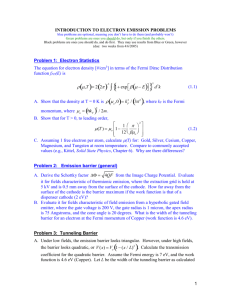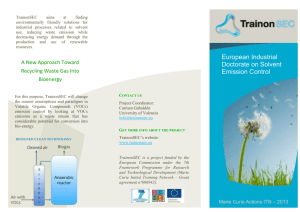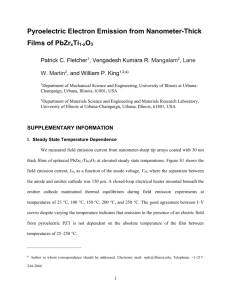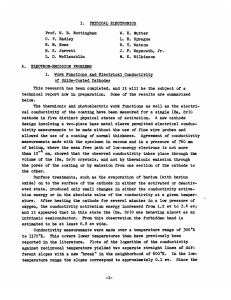Thermoelectric & Field Emission Problems | University Physics
advertisement
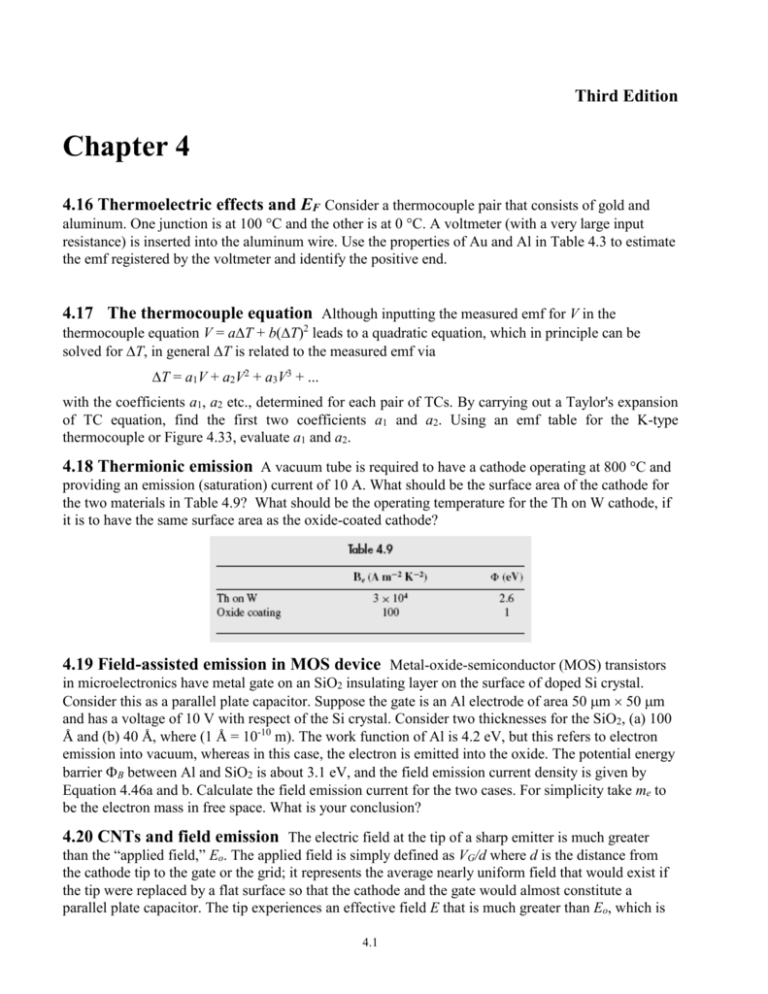
Third Edition Chapter 4 4.16 Thermoelectric effects and EF Consider a thermocouple pair that consists of gold and aluminum. One junction is at 100 C and the other is at 0 C. A voltmeter (with a very large input resistance) is inserted into the aluminum wire. Use the properties of Au and Al in Table 4.3 to estimate the emf registered by the voltmeter and identify the positive end. 4.17 The thermocouple equation Although inputting the measured emf for V in the thermocouple equation V = aT + b(T)2 leads to a quadratic equation, which in principle can be solved for T, in general T is related to the measured emf via T = a1V + a2V2 + a3V3 + ... with the coefficients a1, a2 etc., determined for each pair of TCs. By carrying out a Taylor's expansion of TC equation, find the first two coefficients a1 and a2. Using an emf table for the K-type thermocouple or Figure 4.33, evaluate a1 and a2. 4.18 Thermionic emission A vacuum tube is required to have a cathode operating at 800 C and providing an emission (saturation) current of 10 A. What should be the surface area of the cathode for the two materials in Table 4.9? What should be the operating temperature for the Th on W cathode, if it is to have the same surface area as the oxide-coated cathode? 4.19 Field-assisted emission in MOS device Metal-oxide-semiconductor (MOS) transistors in microelectronics have metal gate on an SiO2 insulating layer on the surface of doped Si crystal. Consider this as a parallel plate capacitor. Suppose the gate is an Al electrode of area 50 m 50 m and has a voltage of 10 V with respect of the Si crystal. Consider two thicknesses for the SiO2, (a) 100 Å and (b) 40 Å, where (1 Å = 10-10 m). The work function of Al is 4.2 eV, but this refers to electron emission into vacuum, whereas in this case, the electron is emitted into the oxide. The potential energy barrier B between Al and SiO2 is about 3.1 eV, and the field emission current density is given by Equation 4.46a and b. Calculate the field emission current for the two cases. For simplicity take me to be the electron mass in free space. What is your conclusion? 4.20 CNTs and field emission The electric field at the tip of a sharp emitter is much greater than the “applied field,” Eo. The applied field is simply defined as VG/d where d is the distance from the cathode tip to the gate or the grid; it represents the average nearly uniform field that would exist if the tip were replaced by a flat surface so that the cathode and the gate would almost constitute a parallel plate capacitor. The tip experiences an effective field E that is much greater than Eo, which is 4.1 expressed by a field enhancement factor β that depends on the geometry of the cathode–gate emitter, and the shape of the emitter; E = βEo. Further, we can take e2ff 3 / 2 in Equation 4.46. The final expression for the field-emission current density then becomes J 6.44 107 3 / 2 1.5 106 2 2 10.4 Eo exp 1/ 2 exp E o [4.85] Where J is in A cm-2, Eo is in V cm-1, and is in eV. For a particular CNT emitter, = 4.9 eV. Estimate the applied field required to achieve a field-emission current density of 100 mA cm-2 in the absence of field enhancement (β = 1) and with a field enhancement of β = 800 (typical value for a CNT emitter). [Revised 22 January 2006] 4.21 Nordhein-Fowler field emission in a FED Table 4.10 shows the results of I-V measurements on a Motorola FED microemitter. By a suitable plot show that the I-V follows the Nordheim-Fowler emission characteristics. Can you estimate ? 4.2

